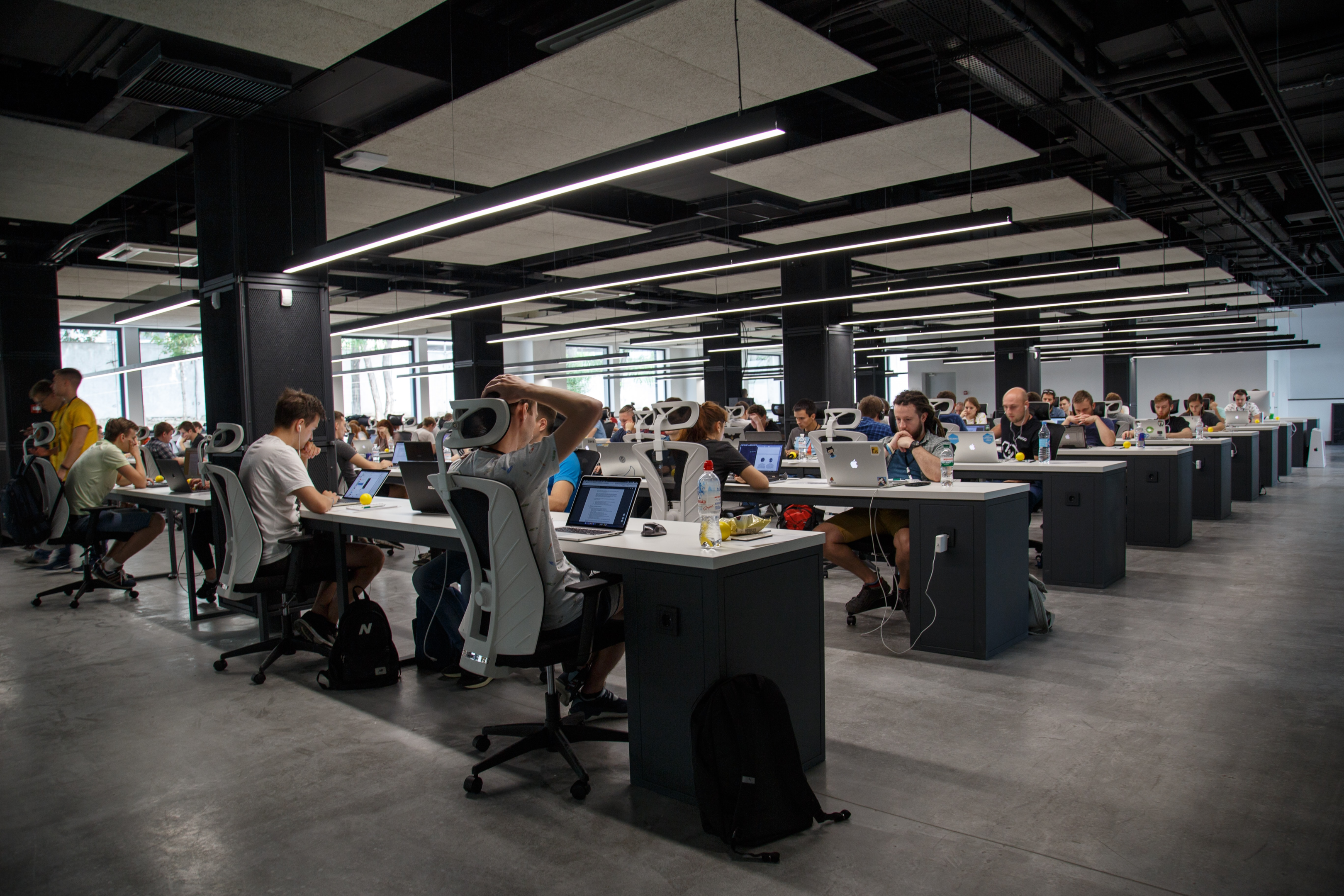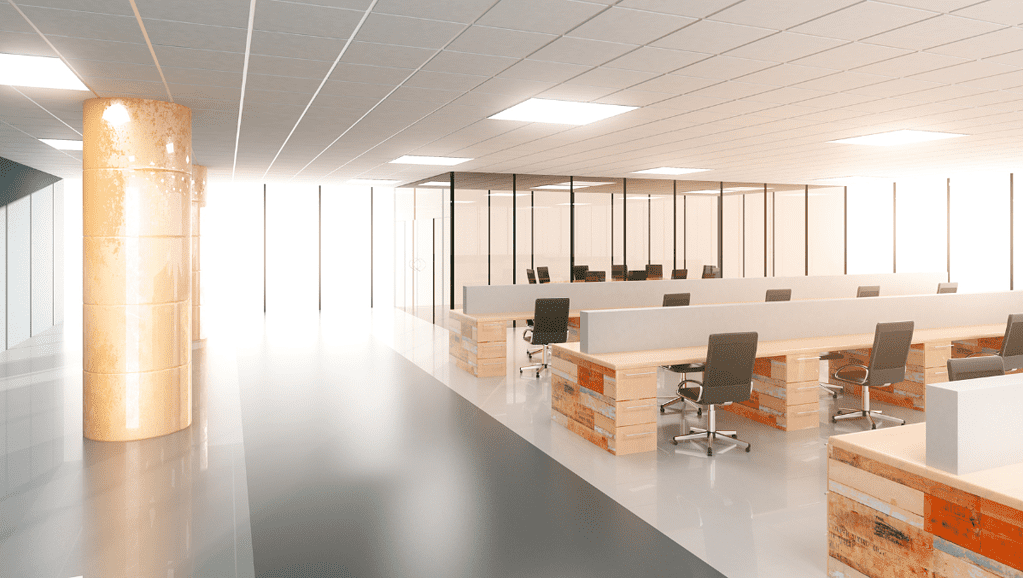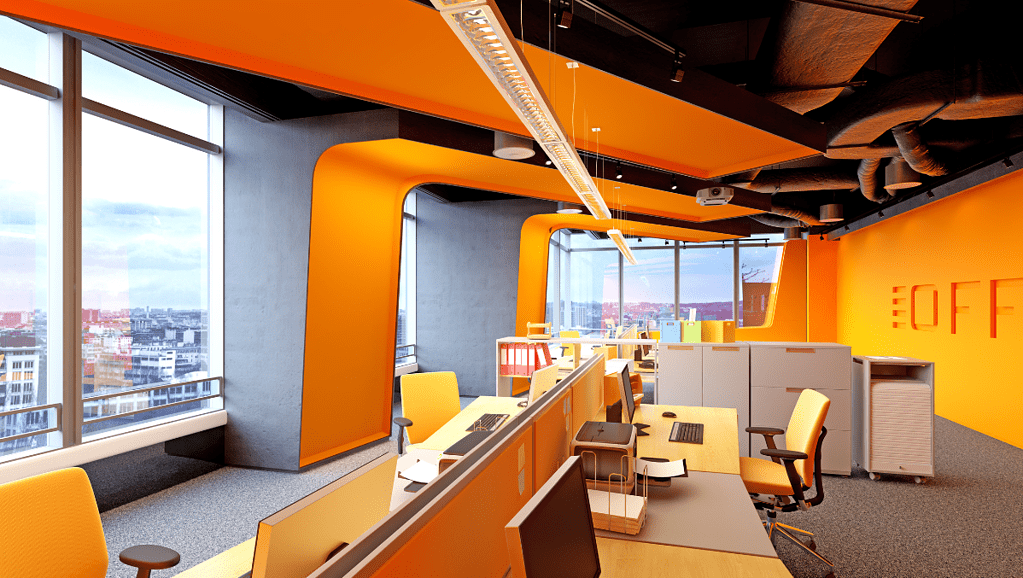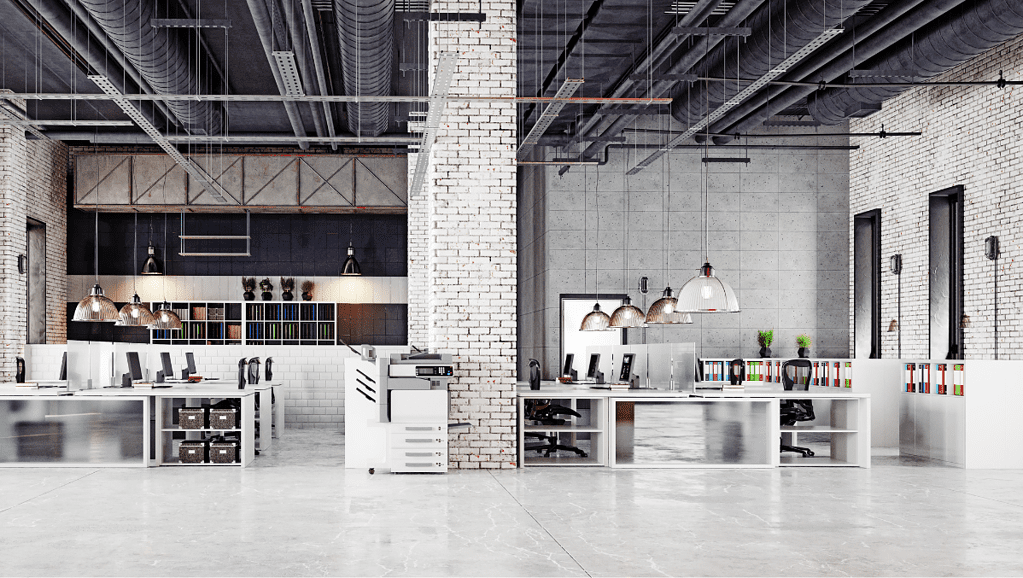But what are the factors that you should consider while choosing office lighting? In this article, we will talk about the best lighting practices that improve the work environment. We’ll cover the types of lighting fixtures, brightness, color temperature, and more.

The Importance of Office Lighting
Before jumping to solutions, it’s crucial to understand how lights affect a worker’s energy, mood, motivation levels, and productivity.
Studies have shown that brightness levels and color temperature can significantly affect a person’s sleep cycles—called Circadian Rhythms. Your body’s circadian clock perceives light as a signal to be alert and active and dark as a signal to relax and sleep.
This is why blue light and cool color temperatures can enhance the alertness and focus of an individual, while dim and warm lighting can slow you down.
Lighting fixtures that tend to flicker, shine and cause glare can trigger headaches and migraines in people. Flickering can induce stress in the eyes and lead to eye disorders in the long run. If your workers spend 7-8 hours daily in poorly designed lighting, they can develop severe stress that can take the form of mild depression and restlessness.
How to Choose Office Lighting?
Here are the most important factors that can make or break your office lighting design:
1. Brightness
The brightness of a lamp is measured in lumens, and the amount of light output in a unit area is measured in lux (lx). Brightness levels of 500-1000 lx are considered optimum for an office setting. Some rooms in an office may demand brighter lighting for more detail-oriented tasks. You can choose 1500-2000 lx for such instances. You can select a combination of varying brightness levels, depending on the nature of functions performed in the room.

For example, an area where employees work on laptops and computer screens does not require harsh and high-brightness lighting. Screens are best visible in neutral and natural lighting.
Lighting that is too bright can make workers’ eyes stressed and tired. The same is the case when the lighting is too dim.
To achieve 500 lux in an area, you need a bulb with approximately 1000 lumens. Similarly, to achieve 1000 lux in a room, you need a bulb or a combination of bulbs with a total of 2000 lumens.
2. Color Temperature
Color temperature is the color of the light visible to the naked eye. It ranges between warm, yellowish tones and cool, blue tones. Office spaces require cool and neutral shades within the range of 4000K-6000K. Cool lights increase the focus and the ability to perform tasks vigilantly.
If the light is too warm, it creates a relaxing vibe in the room, decreasing your workers’ performance. If the color temperature is too much toward the higher end of the spectrum, it can strain the eyes and cause headaches and tiredness.

3. Color Rendering Index (CRI)
The color rendering index defines how clear and sharp a color looks in artificial lighting compared to sunlight. Since office lighting should be as close to natural daylight as possible, a CRI of 75—the CRI of sunlight—should be considered while lighting up an office space.
LEDs generally have CRI greater than 75, making them an optimum solution for office lighting.
4. Bulb Type
Out of the many bulb types—fluorescent, incandescent, halogen, and LED —you can choose any that suits your budget and lighting design. However, we suggest you go for LED bulbs because of their vast benefits.
- LEDs come in various color temperatures, brightness, and better CRIs. Nowadays, LEDs are preferred in modern office spaces because they come in varying sizes and decorative designs.
- LEDs save much energy, cutting your electricity bills in the long run.
- LEDs don’t require much maintenance and last longer than all the other bulb types.
- LEDs can prevent eye strains, headaches, migraines, and tiredness.
9 Tips for Creating the Best Office Lighting Design
Here are a few tips to keep in mind while designing office lighting. These factors are essential in accentuating your office setting and helping your workers perform better.
1. Incorporate Natural Light
The best practice is to incorporate natural light in the office setting. Exposing workers to natural light during day time makes them fresh and active. If your office has large windows or ceiling glass, you can dim artificial lights during the daytime.
A study published by National Sleep Foundation explored how workers exposed to sunlight during work hours had better sleep cycles than those not. Sunlight improves their circadian rhythm, helps them properly replenish their energy during the night, and come to work the next day fresh and happy.
In another study, Dr. Alan Hedge says that natural light prevents eyestrain, headache, and tiredness and improves work quality as workers make fewer mistakes.
If the office setting doesn’t have a lot of windows, you can use tunable lights that mimic sunlight. These lights automatically change the temperature according to the position of the sun. When the sun is at its peak, the color temperature is 6500K, and as dawn approaches, the color temperature shifts to 1800K.
But while combining artificial and natural light, you should remember that direct sunlight can cause glare on screens. The working desk and sitting area should be positioned to reduce glare and provide homogeneous sunlight.

2. Eliminate Glare and Shadows
Glare can reduce visibility and agitate the workers. Moreover, glare can reduce the visibility of the screens of mobiles and laptops and cause eye strain.
LED lights are unidirectional, which helps in reducing glare compared to incandescent and halogen bulbs.
You can also reduce glare by choosing a lamp design in which light is recessed inside the fixture. Another way is to incorporate micro prismatic diffusers in LED fixtures so light is dispersed homogenously across the room. You can use secondary optics such as lenses and reflectors on LEDs to further control and diffuse light according to your needs. Desk lamps should have shade and lenses that diffuse the light homogenously across a worker’s table.
Moreover, reduce shadows by increasing the bulbs you use in an office space. Alternatively, you can choose bigger lighting fixtures instead of smaller lamps to cover all the dark areas.
3. Use Corrective Lights
Corrective lights are a great addition in an office setting because they help eliminate reflected or direct glare on screens. Such lights are typically placed behind the screens to obliterate glare. Pairing them up with ambient lighting can create a comfortable environment where screens can be used for hours without hurting the eyes.
If you’re combining artificial and natural lights, consider adding corrective lights to balance the overall lighting.
4. Consider the Light Placement
One of the most crucial things a designer should consider is the placement of lights. You should start by analyzing the office space, area, height of ceilings, and the number of windows to decide the number of lights required and the optimum spacing between them.
Ensure the lights are not placed directly over the work area, such as overhead lights, as they can cause glare and reduce visibility. No light should be placed directly over the employee’s head.
5. Use a Combination of Lights
Combining several different types of fixtures is always the best way to light up any space. An office is no exception. You can use direct lights, indirect direct, and shielded lights to create a balanced, well-lit, and comfortable vibe across every room.
Aim for creating ambient light by combining optimum color temperature, brightness, and varying light sources.

6. Incorporate Modern Lighting Solutions
Nothing can beat the lighting that can be customized according to the needs. Dimmable lights are a great option if you want people in the room to customize their lights according to their preferences. Overhead or desk lighting must be tunable so workers can change the light intensities however they like.
Smart LEDs have a high initial cost, but they pay off greatly in the long run. One can change the brightness levels and color temperatures to match their needs.
Another modern solution is to opt for solar lights. Solar LEDs reduce power consumption tremendously. Although this lighting solution demands a considerable investment, it pays off in the long run with reduced electricity bills.
7. Don’t Forget the Outdoor Lighting
Office buildings and the areas surrounding the primary office setting must also be optimally lit with decorative lighting fixtures. The entrance and exit must be labeled with respective signs, and the lighting should be comfortable and welcoming. Ensure the front of the building and parking lot is well-lit for visitors and employees.
8. Maintain the Lighting System
Maintenance of the lighting system in an office is of utmost importance. The owner is responsible for arranging periodic maintenance to check, regulate or replace lighting fixtures that are malfunctioning and flickering.
Some lights overheat quickly and have a short life. Low-quality lights can also result in an explosion. Regular maintenance can significantly reduce the chances of such events.
9. Follow the Lighting Regulations
Some countries have lighting rules and regulations that you should follow while designing lighting for an office area. These regulations are based on the nature of work, the workers’ health, maintenance, emergency lighting, and power usage.
Types of Lights Best for an Office Setting
Until now, we have established how crucial lighting is for the productivity, safety, and appeal of an everyday office. Let’s discuss what types of light fixtures will help you create the best lighting design for the workplace.
Task Lights
Task lights are the most crucial element of any work environment. Their whole purpose is to illuminate the working area that requires utmost attention.

All office places have dedicated areas for essential tasks, such as conference rooms, work desks, testing labs, pantries, and IT rooms. Dim and subpar lighting in such areas can adversely affect productivity and result in a loss of business.
LED spotlights, track, and linear lights are your best option for efficient task lighting. Just because these lights are there for a specific purpose doesn’t mean they have to be boring. You can choose from tons of designs, colors, and types of modern task lights that complement your workplace ambiance.
Panel Lights
Panel lights are rectangular fixtures with multiple lamps attached to the office ceiling. They are most popular for large working areas or halls with numerous cubicles and workstations for employees. So, the panel lights illuminate a general area instead of providing lights to a specific place.
Fluorescent lights and LEDs are most commonly used in panel lights. Moreover, it’s the most energy-efficient and cost-effective lighting solution out there.
Panel lights have a simpler design, but that doesn’t take away the elegance of this luminaire. It creates a mature and focused environment that increases the productivity of the offices.
Recessed Lights
Recessed lights are attached to the ceiling with fixtures inserted in the drywall and hidden from sight. It gives an illusion of more space and a minimalistic design that most designers prefer. Offices are already cluttered with files, people, and equipment, so it’s nice to have luminaire that makes the place less tense.
Traditionally, designers used halogen recessed lights, but now LED lights are preferred because they release less heat and last longer. New LED recessed lights also have thin fixtures, which consume even less space.
Recessed lights are more difficult to install than other luminaires because they require a space in the ceiling for the heat sink, circuit board, drivers, and wires. New constructions are designed to leave space for recessed lights. If not, a drywall ceiling is added, and recessed lights are installed.
Suspended Ceiling Lights
Suspended lights are best for taller office ceilings. The higher the ceiling is, the more powerful the lights need to be for better lighting. Higher-wattage lights can ramp up your electricity bills and maintenance costs.

So, it’s best to install low-power luminaire using suspended ceiling fixtures. These fixtures reduce the overall height resulting in better illumination for your employees.
Suspended linear lights and batten lights are popular choices for workstations. Moreover, these lights can act as task lighting for your employees.
A pendant light is another popular example of suspended lighting. It not only provides general lighting but can also enhance the appeal of the office place.
Many stylish pendant lights can add to the office’s appeal, making them less boring.
Strip Lights
Strip lighting refers to led strips attached to lengthy and flexible wire strips. Such strips can be attached to the corners of the wall and create a wall-washing effect. LED strip lights create diffused lights that work best to create minimalistic vibes.
Indirect lighting using LED strips can be used in general areas like waiting rooms, conference halls, and lobbies. Moreover, they come in various colors and temperatures, giving you plenty of creative room.
What to Avoid in an Office Space?
Following are the most common mistakes that are seen in an office setting. Avoiding them can make a huge difference.
1. Overhead Lighting
Light placed directly over the heads of the workers is a bad idea. Placing lights at an angle will prevent glare on the screens and will not strain workers’ eyes. If the lights are fixed, you can change the setting and layout of the office such that the lights do not cause glare.
2. Not Using Smart LED Technology
Invest in lighting that is adjustable and customizable. Give your workers control to change and alter the brightness and colors according to their needs. Smart LED technology offers a variety of features, such as workers can dim the lights and increase or decrease the brightness intensity. You can also program the lights to dim or change colors at specific times throughout the day.
Final Thoughts
Lighting in an office setting can make or break the mood of your employees. It can affect productivity and, in extreme cases, develop eye disorders, migraines, and depression.
After reading this article, we hope you understand what is important for office lighting design. Make sure you choose neutral and cool color temperatures, high CRI, and fixture designs that reduce glare. You may need to combine more than one type of light to create a homogenous ambiance. Choose smart LED technology and give your workers the control to change their lighting settings.
Lastly, try to use natural light as much as possible. Your workers will thank you for that.
RC Lighting Can Take Your Office Lighting to the Next Level!
RC Lighting has helped many clients build their desired office lighting settings. You could be next. Book a consultation with our team of designers, and we will walk you through each step of selecting the optimum office lighting for your project.
Choose your desired office lights from our vast catalog of high-quality architectural, recessed, spotlights, task lights, and much more. We will deliver our tested, guaranteed products within the shortest lead time to your doorstep. Call us right now and discuss your next lighting project with us.



